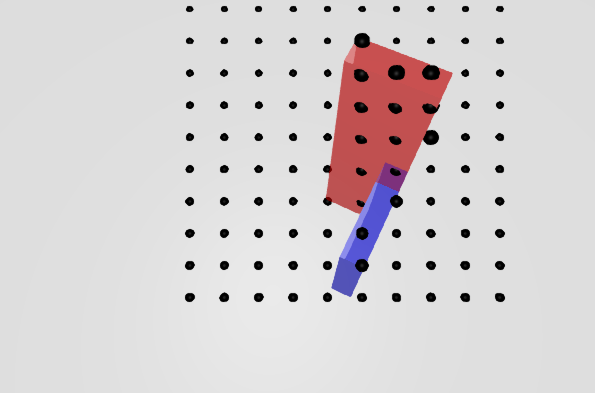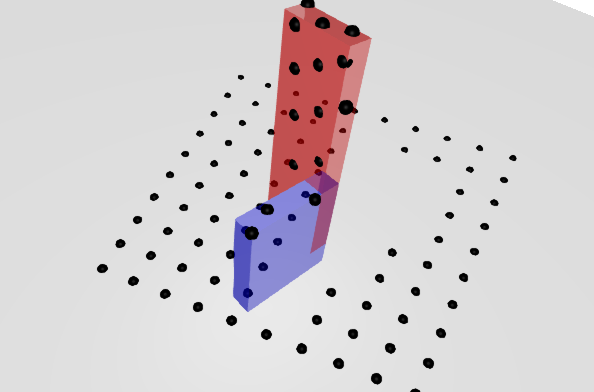Robot visualization tool using OpenGL backend. The API proposed in this package is heavily inspired from MeshCat.jl. The reason for developing this package was to access depth information from a camera view. A tutorial on doing just this is provided below.
resolution = (600, 400)
vis = GLVisualizer(resolution=resolution)
open(vis)
set_floor!(vis, color=RGBA(0.4, 0.4, 0.4, 0.2))
object1 = HyperRectangle(Vec(0,0,0), Vec(0.2, 0.9, 1))
object2 = HyperRectangle(Vec(0,0,0), Vec(0.6, 0.2, 2.0))
add both objects to the scene, this defines a tree representation: root -> object1 -> object2. Moving the frame of object1 will move object2 accordingly.
setobject!(vis, :root, :object1, object1, color=RGBA(0,0,1,0.4))
setobject!(vis, :object1, :object2, object2, color=RGBA(1,0,0,0.4))
eyeposition = [0,2,5.0]
lookat = [1,0,0.0]
up = [0,0,1.0]
set_camera!(vis;
eyeposition=eyeposition,
lookat=lookat,
up=up,
far=100.0,
near=0.1,
zoom=1.0,
)
settransform!(vis, :object1, [0,0,0.50], Makie.Quaternion(0,0,0,1.0))
settransform!(vis, :object2, [0,0,0.25], Makie.Quaternion(0,0,0,1.0))
depth = depth_buffer(vis)
maximum(depth)
minimum(depth)
depth = depth_buffer!(depth, vis)
maximum(depth)
minimum(depth)
p1 = Vector(range(200, step=32, length=10))
p2 = Vector(range(100, step=32, length=10))
n1 = length(p1)
n2 = length(p2)
world_coordinates = zeros(3, n1 * n2)
depthpixel_to_world!(world_coordinates, depth, p1, p2, vis)
pixel_object = HyperSphere(Point{3}(0,0,0.0), 0.05)
for i = 1:size(world_coordinates, 2)
setobject!(vis, :root, Symbol(:pixel, i), pixel_object, color=RGBA(0.0,0.0,0.0,1.0))
settransform!(vis, Symbol(:pixel, i), world_coordinates[:,i], Makie.Quaternion(0,0,0,1.0))
end
linear_depth = (depth .- minimum(depth)) ./ (maximum(depth) - minimum(depth))
point_depth = deepcopy(linear_depth)
for i in p1
for j in p2
point_depth[i .+ (-4:4), j .+ (-4:4)] .= 1.0
end
end
Plots.plot(Gray.(1 .- rotl90(linear_depth)))
Plots.plot(Gray.(1 .- rotl90(point_depth)))



